
The fire thong is a fire-by-friction technique that was utilized in Southeast Asia and Papua New Guinea. This unique fire making method required a split branch for the heathboard and a piece of split rattan. The rattan thong was sawed back and forth against the underside of the hearthboard.
The hearthboard was prepared three different ways. For each method, the hearthboard has an overall general configuration. Imagine a piece of branch split in half. The top side is flat from the split and the other side is rounded due to the curve of the branch.
1) For one method of preparing the hearthboard, a V-shaped trough is carved in the center of the top, flat side of the hearthboard. A punctured hole is drilled to the base of the trough on the middle of the curved side. The hole is less than 1/8 inch (.3175 cm) in diameter. A shallow slot is cut over the tiny hole to guide the split rattan.
2) For the second method of preparing the hearthboard, the hearthboard is bound about 6 to 7 inches down the end of the wood. The end is split crosswise and a wooden wedge is placed to hold the split open. The binding keeps the wood from splitting further. The thong is positioned underneath the narrow gap.
3) For the third method of preparing the hearthboard, a conical shaped hole is bored on the flat side of the hearthboard. On the middle of the curved side, a very small hole punctures the bottom of the conical crater. The pierced hole is less that 1/8 inch (.3175 cm) in diameter. A slight groove is whittled alongside the minuscule hole to hold the split rattan.
The grips for the end of the split rattan were either coiled rattan, wooden toggles or the cut ends of the rattan. When rattan was prepared and carried, it was stored in a tightly coiled configuration. When needed, the fire maker unraveled one end to the desired length and wound the rest of the end for a hand hold. The other coiled end became the other hand grip. When toggles were utilized, the rattan was cut to the required length and the ends were thinned to tie an overhand knot to secure the short wooden stick. The last method for gripping the rattan was to cut the split rattan to a suitable length and just grab the cut ends of the rattan as the hand hold.


Above photos by Ash Kivilaakso
The images are from a cave in Malaysia. The first photo shows a series of holes on the top side of the hearthboard. The second photo depicts the underside of the hearthboard. Notice the rattan thong lying next to the hearthboard. Dried elephant dung was used for the tinder.

A native man from Irian Jaya using a fire thong.
Here are two YouTube videos of a Malaysian fire thong and an Indonesian fire thong:
Youtube video 1
Youtube video 2
My experience with the fire thong:
1) The materials I've used for the hearthboard are basswood, redwood, sotol, cedar and elderberry. Rattan was utilized for the thong.
2) I purchased some 26" natural rattan escrima sticks from Amazon.com. Escrima, arnis or kali are the traditional martial arts of the Philippines that emphasize weapon-based fighting with rattan sticks, knives and other bladed weapons. The rattan sticks that I bought were split into quarters, then split again to the desired thickness for the fire thong. The length of my thong was about 1 1/2 to 2 feet long, not including the length I use to tie the wooden toggles, which are utilized for hand grips. I tie an overhand knot to secure the short sticks. The ends of the dry, split rattan is first soaked in lukewarm water until it becomes pliable. This allows me to tie a tight knot onto the toggle without cracking the split rattan.
Below are photos of the rattan thong with the wooden toggles. The first photo has a split rattan that came from a whole cane that was originally used for caning chairs. The material proved to be unsuccessful for my needs. The whole cane was rather small in diameter. When I split it, it was thin and broke during the vigorous pulling motion of the critical ignition phase. Using the whole cane without splitting it would have broken or cracked easily. I believe the rattan has to be split due to the stresses applied to the material. It is like the design of a bow. The outer part of the bow wood will take tension and the inner part of the bow wood will take compression. If you bend a whole branch, it will snap in two.
The second photo has a piece of rattan that I took apart from the weft and warp of a rattan basket. The rattan was a bit thicker on the baskets, but the materials were not consistent in thickness. The rattan escrima sticks were a better material for making thick, split rattan for the thong.
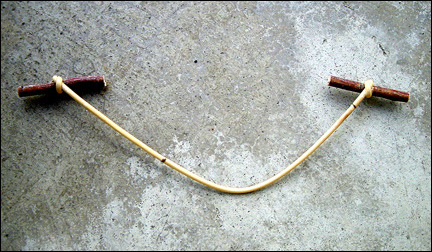
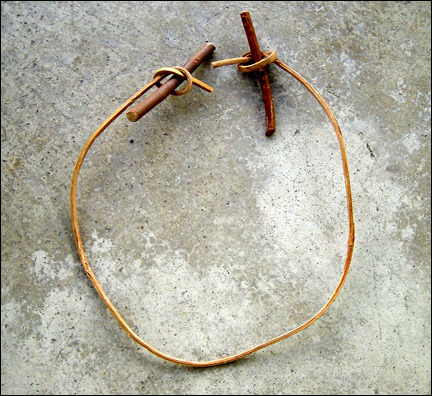
The first photo below shows the various preparations of the hearthboard. Starting from the left is the V-shape trough method using basswood. The next hearthboard utilizes the split wedge technique on a cedar board. The third hearthboard is an elderberry with a conical shaped hole and the fourth hearthboard, which is basswood, has the same approach of also creating a hole on the flat side. The second photo shows the underside of the hearthboard. The dark, scorched lines are where the rattan thong was sawed against the hole or the open wedge using the back and forth motion of pulling on the wooden toggles.
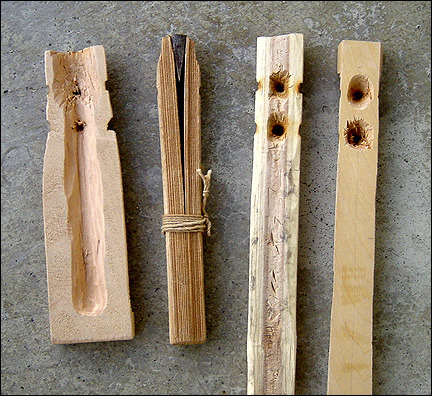
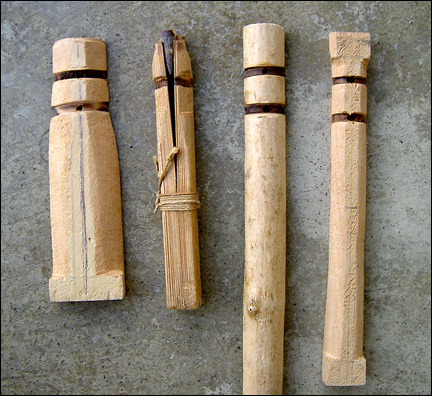
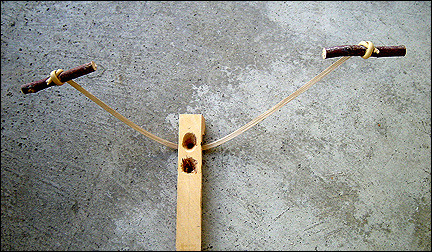
The photo shows how the rattan thong is aligned with the conical hole underneath the hearthboard.
I haven't tried it yet, but I believe a strip of bamboo can be substituted for the rattan thong. The bamboo has to be split into lengthwise strips and thinned out on the interior section of the strip. The strip should be thick enough to supply the needed dust that will accumulate in the conical hole during the sawing process and not be too thin that it will break under pressure. A main concern is the area of the nodes, where the material is thicker, denser and less flexible. The thong can be made pliable during the initial sawing process. Taking a wide position with your arms, begin sawing slowly back and forth with the bamboo thong. As the strip heats up, it should become more bendable. The arms are then brought closer together and the sawing pace is quickened. Hopefully, the bamboo thong will not crack or break and, if all goes well, you'll get a smoking ember. That's the hypothesis.
I've tried a split wild grape vine, but the material could not withstand the pressure and it snapped. It broke before any dust gathered in the hearthboard hole. The thong has to have certain characteristics that will allow it to work. The material has to be relatively long, flexible when dry, able to withstand heat before breaking, must be soft enough to abrade to dust, and strong enough to take the pressure of being constantly pulled without immediately snapping or splintering. It's quite a lot to ask from a natural material.
I created a YouTube video to demonstrate the use of the fire thong. The split rattan is placed under the hearthboard coverng the tiny hole. With my hands slightly apart, I began sawing back and forth to warm up the rattan to make it more flexible. As my hands were brought closer together, my pace quickened. When the hearthboard started to smoke, I utilized my upper torso to pull upwards at my waist to create more friction. I began using shorter and faster strokes. Char dust accumulated in the conical hole and eventually ignited from the high temperature.
Excerpt from "Fire-Making Apparatus in the United States National Museum" by Walter Hough:
"Henry Balfour has most successfully monographed the fire thong. The method has been found in use in southeastern Asia and the Asiatic islands; in New Guinea; West Africa, and western Europe.
At first sight it would seem necessary to limit the fire thong method to the area of the distribution of the rattan, whose strong texture admits of the hard usage required in making fire. This is generally the case, as it is difficult in other parts of the world to supply the thong material. Some thongs of bark, however, or strips of flexible bamboo, are used in areas where the rattan does not occur.
Matthew W. Stirling, on his expedition to Central New Guinea in conjunction with the Dutch Government, found the fire thong in use among the Pygmies and the fringing Pygmy-Papuan tribes. Curiously enough he found the method employed in sawing down trees. This is quite suggestive of a way by which the fire thong may have been discovered.
The Battaks of the island of Palawan in the Philippines use the thong fire kindler. The thong of rattan is wound into a wristlet and worn till needed. The stick is cleft and held open by a bit of stone."
E-mail your comments to "Dino Labiste" at KahikoArts@yahoo.com
We hope the information on the PrimitiveWays website is both instructional and enjoyable. Understand that no warranty or guarantee is included. We expect adults to act responsibly and children to be supervised by a responsible adult. If you use the information on this site to create your own projects or if you try techniques described on PrimitiveWays, behave in accordance with applicable laws, and think about the sustainability of natural resources. Using tools or techniques described on PrimitiveWays can be dangerous with exposure to heavy, sharp or pointed objects, fire, stone tools and hazards present in outdoor settings. Without proper care and caution, or if done incorrectly, there is a risk of property damage, personal injury or even death. So, be advised: Anyone using any information provided on the PrimitiveWays website assumes responsibility for using proper care and caution to protect property, the life, health and safety of himself or herself and all others. He or she expressly assumes all risk of harm or damage to all persons or property proximately caused by the use of this information.
© PrimitiveWays 2016